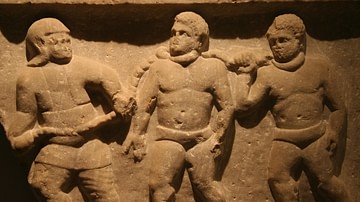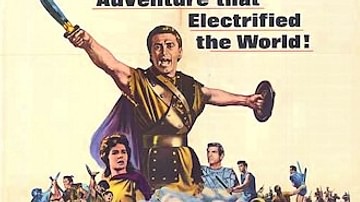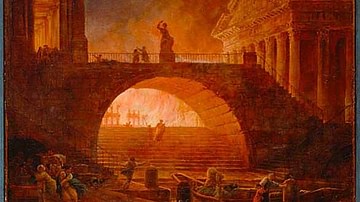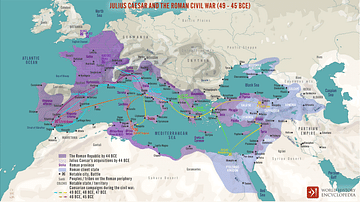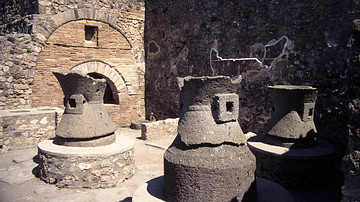Slavery was an ever-present feature of the Roman world. Slaves served in households, agriculture, mines, the military, workshops, construction and many services. As many as 1 in 3 of the population in Italy or 1 in 5 across the empire were slaves and upon this foundation of forced labour was built the entire edifice of the Roman state.
Slavery as An Accepted Reality
Slavery, that is complete mastery (dominium) of one individual over another, was so imbedded in Roman culture that slaves became almost invisible and there was certainly no feeling of injustice in this situation on the part of the rulers. Inequality in power, freedom and the control of resources was an accepted part of life and went right back to the mythology of Jupiter overthrowing Saturn. As K.Bradley eloquently puts it, 'freedom...was not a general right but a select privilege' (Potter, 627). Further, it was believed that the freedom of some was only possible because others were enslaved. Slavery, was, therefore, not considered an evil but a necessity by Roman citizens. The fact that slaves were taken from the losers in battle (and their subsequent offspring) was also a helpful justification and confirmation of Rome's (perceived) cultural superiority and divine right to rule over others and exploit those persons for absolutely any purpose whatsoever.
Aside from the huge numbers of slaves taken as war captives (e.g. 75,000 from the First Punic War alone) slaves were also acquired via piracy, trade, brigandage and, of course, as the offspring of slaves as a child born to a slave mother (vernae) automatically became a slave irrespective of who the father was. Slave markets proliferated, perhaps one of the most notorious being the market on Delos, which was continuously supplied by the Cilician pirates. Slave markets existed in most large towns, though, and here, in a public square, slaves were paraded with signs around their necks advertising their virtues for prospective buyers. Traders specialised in the commodity, for example, one A. Kapreilius Timotheus traded throughout the Mediterranean.
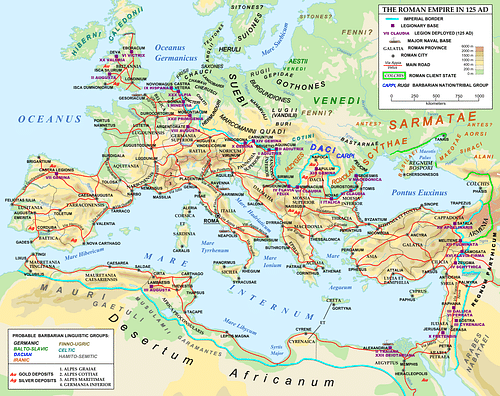
The Status of Slaves
The number and proportion of slaves in society varied over time and place, for example, in Augustan Italy the figure was as high as 30% whilst in Roman Egypt slaves made up only 10% of the total population. Although slave ownership was wider than in the Greek world, it remained a prerogative of the reasonably well-off. A more modest Roman business owner, artisan or military veteran might own one or two slaves whilst for the very wealthy, the number of slaves owned could run into the hundreds. For example, in the 1st century CE, the prefect L. Pedanius Secundus had 400 slaves merely for his private residence.
Slaves were the lowest class of society and even freed criminals had more rights. Slaves had no rights at all in fact and certainly no legal status or individuality. They could not create relations or families, nor could they own property. To all intents and purposes they were merely the property of a particular owner, just like any other piece of property - a building, a chair or a vase - the only difference was that they could speak. The only time there was anywhere near equality for all persons in Roman society was during the Saturnalia festival when, for a few days only, slaves were given some freedoms usually denied them.
Slaves were, for many of the Roman elite, a status symbol and, therefore, the more (and the more exotic) one had, the better, so that wealthy Romans very often appeared in public accompanied by an entourage of as many as 15 slaves.
The Roles of Slaves
Slave labour was used in all areas of Roman life except public office. In addition, slaves were often mixed with free labour as employers used whatever human resources were available and necessary to get a job done. If one could not find enough slaves or skills were needed which only paid labour could provide, then labourers and slaves would work together. In the agricultural sector such a mix of labour was particularly common as the work was seasonal so that at harvest time paid labour was brought in to supplement the slave staff because to maintain such an extended work force year-round was not economically viable.
Slaves, then, were employed by private individuals or the state and used in agriculture (especially the grain, vine and olive sectors), in mines (especially for gold and silver), manufacturing industries, transportation, education (where they brought their specialist knowledge of such topics as philosophy and medicine to the Roman world), the military (principally as baggage porters and camp assistants), the service industries (from food to accounting), in the private home, in the construction industry, on road-building projects, in public baths, and even to perform tasks in certain cult rituals.
The lot of agricultural slaves (vincti) was probably one of the worst as they were usually housed in barrack buildings (ergastula) in poor, prison-like conditions and often kept in chains. Pompeii has revealed such work gangs chained together in death as they were in life. Other skeletal remains from Pompeii have also revealed the chronic arthritis and distortion of limbs that could only have been produced by extreme overwork and malnutrition.
winning Freedom
There was, at least for a small minority, the possibility of a slave achieving freedom to become a freedman or woman, and this incentive was fully exploited by slave owners. That manumission occurred is attested by the many ancient references, both in literature and art, to the presence of freed slaves. Freedom could be granted by the owner but in most cases was actually bought by the slaves themselves, allowing the owner to replenish his workforce. Freedom could be absolute or might be limited and include certain obligations to the former owner such as inheritance rights or the payment of a portion (statuliber) of their earned assets (peculium). The freed slave often took the first two names of their former master, illustrative that manumission was rare, as the family name held great importance in Roman society so that only the most trusted individual would be allowed to 'wear' it.
Children of a freed woman would not have any limits on their rights (although social status might be affected in terms of reputation). Also, former slaves could become citizens (especially from the Augustan period) and even become slave owners themselves. One famous example was the freedman C. Caecilius Isidorus who would eventually own over 4,000 slaves. This prize of freedom and integration back into society was also used by owners and authority to convince slaves of the benefits of working hard and obediently.
Slave Rebellions
There is some evidence that slaves were better treated in the Imperial period as fewer wars resulted in slaves being in less ready supply and, therefore, they increased in value and it was recognised that harsh treatment was counter-productive so that there were even laws which provided against excessively cruel owners. However, in practical terms, one can imagine, that owners were at liberty to treat their property as they thought best and the only real constraint was the desire to maintain the value of the asset and not provoke a drastic and collective reaction from those enslaved. Indeed, treatises were written advising the best methods of management regarding slaves - what food and clothing was best, which were the most efficient methods of motivation (e.g. giving time off or better food rations), and how to create divisions amongst slaves so that they did not form dangerous protest groups.
Sometimes, however, these careful plans and strategies proved ineffective and slaves could turn against their owners. Undoubtedly, the most famous examples of such uprisings were those led by Eunus in Sicily in 135 BCE and Spartacus in southern Italy in 73 BCE but slaves could protest against their lot in life in much more subtle ways such as working more slowly, stealing, truancy, and sabotage. We have no records from the viewpoint of slaves themselves but it is not difficult to imagine that, faced with the personal risks to oneself and the relations one might have developed, there was not much a slave could do to change their lot other than hope that one day freedom could be legitimately won.
The case of Spartacus, then, was an unusual but spectacular one. It was not an attempt to overthrow the entire system of slavery but rather the actions of a disaffected group willing to take the risk to fight for their own freedom. Spartacus was a Thracian gladiator who had served in the Roman army and he became the leader of a slave rebellion beginning at the gladiator school of Capua. Supplementing their numbers with slaves from the surrounding countryside (and even some free labourers) an army was assembled which numbered between 70,000 and 120,000. Amazingly, the slave army successively defeated two Roman armies in 73 BCE. Then in 72 BCE Spartacus defeated both consuls and fought his way to Cisalpine Gaul. It may have been Spartacus' intention to disperse at this point but with his commanders preferring to continue to ravage Italy, he once more moved south. More victories followed but, let down by pirates who had promised him transportation to Sicily, the rebellion was finally crushed by Marcus Licinius Crassus at Lucania in 71 BCE. Spartacus fell in the battle and the survivors, 6000 of them, were crucified in a forceful message to all Roman slaves that any chance of winning freedom through violence was futile.
Conclusion
The entire Roman state and cultural apparatus was, then, built on the exploitation of one part of the population to provide for the other part. Regarded as no more than a commodity, any good treatment a slave received was largely only to preserve their value as a worker and as an asset in the case of future sale. No doubt, some slave owners were more generous than others and there was, in a few cases, the possibility of earning one's freedom but the harsh day-to-day reality of the vast majority of Roman slaves was certainly an unenviable one.
